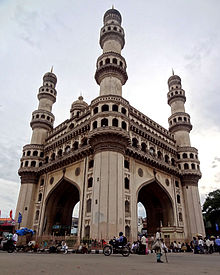Charminar
| Charminar | |
|---|---|
 | |
| Religion | |
| Affiliation | Islam |
| District | Charminar |
| Year consecrated | 1591 (1591) |
| Location | |
| Location | Hyderabad, Telangana, India 17°21′42″N 78°28′29″E / 17.36163°N 78.47467°E |
| State | Telangana |
| Architecture | |
| Architect(s) | Mir Momin Astarawadi[1][2] |
| Architectural style | Indo-Islamic architecture |
| Founder | Muhammad Quli Qutb Shah |
| Specifications | |
| Minaret(s) | 4 |
| Minaret height | 48.7 metres (160 ft) |
| Materials | granite, limestone, mortar and pulverized marble |
The Charminar is a monument and mosque in Hyderabad, India. The structure was built in 1591 AD. It is the most famous building of Hyderabad and also one of the most famous buildings in India.[3] It was built by Muhammad Quli Qutb Shahi to celebrate the end of a deadly plague.[4] The Charminar lies near the bank of the river Musi. It is close to Laad Bazaar and Makkah Masjid.[4] Charminar is taken from two words Char and Minar which translate as Four Towers in English.[4]
Some people say that Charminar was the first structure to be constructed in the newly built city of Hyderabad.[5] It is said that Quli Qutab Shah prayed for the end of the plague and vowed to build a mosque if it was eradicated.[6] Mir Momin Astarabadi, the prime minister of Qutb Shah played an important role in the design and layout of Charminar and the city of Hyderabad.[7] The structure is of Indo-Islamic architecture with some Persian elements.[8]
References
[change | change source]- ↑ Khan, Asif Yar (18 June 2013). "Here sleeps the earliest urban planner". The Hindu.
- ↑ "Remembering the man behind Charminar's architecture". 5 April 2016.
- ↑ "Richard Goslan travels to India – Herald Scotland". Archived from the original on 18 December 2010. Retrieved 27 March 2013.
- ↑ 4.0 4.1 4.2 Charminar: Hyderabad, Britannica Compton's Encyclopedia
- ↑ "The Qutb Shahi monuments of Hyderabad-Golconda Fort, Qutb Shachi Tombs, Charminar". UNESCO World Heritage Centre. Retrieved 27 March 2013.
- ↑ "India: Charminar is in fact a madrasa and masjid". IRIB World Service. Retrieved 27 March 2013.
- ↑ Sardar, Marika (2007). Golconda through time: A mirror of the evolving Deccan (Thesis). New York University. UMI Number:3269810.
- ↑ Gayer, Lauren; Lynton (2011). Muslims in Indian cities: trajectories of marginalisation. Columbia University Press. ISBN 978-0-231-80085-3. Retrieved 27 March 2013.
{{cite book}}: Text "Jaffrelot" ignored (help)
